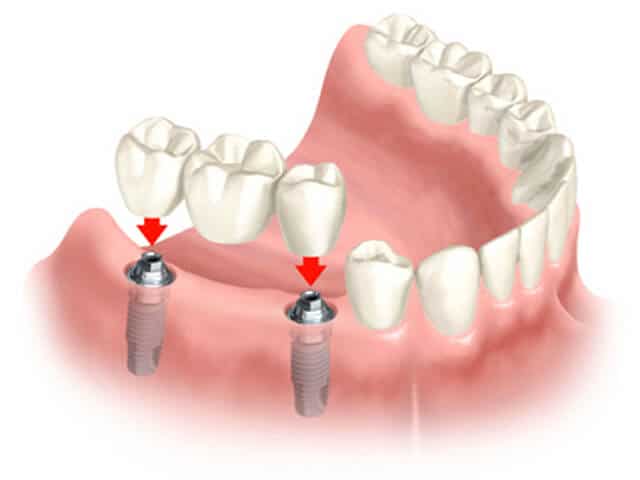What Is A Dental Bridge?
A dental bridge is used to fill a gap caused by missing teeth. It actually ‘bridges’ the gap between teeth to fill in the space.
A dental bridge is mounted to either natural teeth or dental implants. they can be made from porcelain, gold, metal or a combination of the materials.
A dental bridge is some false teeth that are glued in permanently to fill in spaces. Gaps in teeth are filled by the bridge after it is glued in place.
It creates a natural looking smile and gives strong teeth to chew on.
Dental bridges can look fantastic and often last a long time. They are made typically out of ceramics (porcelain) with or without a metal layer underneath.
Dental bridges are custom made to match your particular tooth or implants. They are glued in using strong cement.
What are the benefits of a dental bridge
Dental bridges to replace a missing tooth can have some pretty great benefits. They can be a strong and pretty way to get rid of a gap in between teeth.
- a dental bridge can fill gaps and restore a smile. They replace unattractive gaps natural and beautiful teeth
- a dental bridge can make it easier to chew and eat
- maintaining the shape of your face as missing teeth often result in the face collapsing into the mouth – which is rarely attractive
- Stop the other teeth from moving or drifting into bad positions

What types of dental bridge are there?
Dental bridges can be mounted into teeth or onto implants. There are a few types of dental bridge that might be right for you
- Traditional bridge that is mounted to a tooth or implant at each end
- Cantilever bridge that is mounted to a single tooth or implant
- Maryland bridge is a different type of dental bridge that has wings that are stuck to the tooth in either side
All these type of dental bridges have specific uses that benefit different people. A dentist will be able to identified which type is correct to use in your mouth
What does a dental bridge cost?
Many things will change the cost of a dental bridge. Like all dental work find a quality local dentist you trust and organise for a quote before any work.
The cost of a dental bridge is effected by
- The materials used
- Bonding to teeth or placing implants
- Gum health
- Nerve health
- Jaw bone density
- Aesthetic zone or functional zone
- Number of teeth being replaced
In the USA, a dental bridge will typically cost $2000USD to 4500USD.
In Australia, the range varies but typically $3000-6000 USD depending on the complexity.
It is extremely important to have a quality dentist perform this procedure to the best possible standard – as the forces involved with replacing a missing tooth must be carefully assessed.
How Long Does a Dental Bridge Last
The lifespan of a dental bridge depends on the type of material involved, the way the bridge is looked after, and the way the other teeth bite.
It is commonly said that a dental bridge can be expected to last around ten years (e.g. Colgate, and Web MD).
A 1995 Dutch study of over a thousand (1674 in total) dental bridges found the 87% survival rate at 12 years. (Leempoel, KÄYSER, Rossum (1995)).
This and other studies suggest that if maintained and looked after – dental bridges can last much longer than ten years.
In my practice I have seen bridges that are over forty years old – made on traditional porcelain fused to metal – that are still perfectly working!
How Long Does it Take for a Dental Bridge to Settle
The material used to set most bridges is mostly set by the time you leave the dental office. Many dentists say it is ok to eat on the bridge straight away, or after a short amount of time.
It is not unusual for teeth that have had a bridge placed to experience some initial discomfort.
Many times the patient goes home and tells me the bridge has settled perfectly and the bite is awesome.
For others though, they experience either discomfort to temperatures – or discomfort in the bite.
The factors that make it more likely to have discomfort after bridge seating are
- A more complicated bite
- If there has been a gap for a long time and the other teeth opposite have gotten used to biting on nothing
- If a big filling needed to replaced on the teeth that support the bridge prior to the bridge being made
- If a root canal or nerve treatment has been recently done
- If the patient is prone to sensitive or cold teeth after fillings or crowns
- If the patient is a bruxer (grinds or clenches their teeth!)
For these patients it can take a number of weeks for the bridge to settle in. Dentists do NOT normally expect pain, but some discomfort in the bite or to cold temperatures does occur.
My advice is to call the dental office and check in – just to let the reception know the type of pain or discomfort experienced.
If the dentist is made aware they can offer reassurance or if there is a certain type of worrying discomfort – advice.
Loose Dental Bridge Symptoms
Patients often are unsure about what a loose bridge would feel like. A loose filling or crown often moves or falls out. Because many bridges are attached at two ends – if one end is loose it can feel very strange but perhaps not be moving around much.
The symptoms of a loose bridge that mean you need to book a dental appointment ASAP are
- It moves when it is touched (at all)
- There is hot, cold or sweet sensitivity
- If the bite feels like it has changed
- If there is a bad taste in the mouth – this could be metallic, or just taste awful
What Does a Dental Bridge Infection Feel Like?
Infection of a dental bridge is actually usually an infection of the gums or the teeth that support the bridge.
Infection of a dental bridge has some of the following symptoms
- Sensitivity of the bridge to hot and cold
- Sweet pain
- Pain on chewing despite the bridge not moving
- A really bad taste from around the gum
- A pimple or “sinus” that forms on the gum (and if you poke it.. pus!)
- Swelling in the area or near the face
- Bad breath that cannot be explained by any other cause
If the infection is simply caused by inadequate cleaning – a trip to the dentist and use of some special floss or brushes may settle it down quickly. Mouth rinse is also commonly used to help these settle.
If the infection is caused by the tooth that support the bridge – it is common this will result in either a nerve treatment or an extraction. This is a big deal for a bridge!
The signs of infection near a bridge should not be ignored. Book an appointment with your dentist as soon as you can. If the infection is spreading – seek medical help as a matter of urgency.
How Long Does It Take to Get a Dental Bridge
The length of procedure for a dental bridge will depend on a few things.
- Is it a one sided (cantilever) or two sided bridge
- Are there implants involved
- What material (porcelain, metal or both) will be used
Typically bridges take two visits to be completed. Digital dentists that have the skills and equipment to do same day crowns can sometimes do same day bridges – but this is not the norm.
Where I work we have the most up to date digital scanners and milling units – but typically we use a dental lab for bridge work to ensure quality and strength.
You should expect a a longer first appointment. Typically dentists take from 60-150 minutes for this first appointment, depending on how hard it is.
Then there is a second appointment one ether lab work has been returned. The typical appointment in Australia and the USA is 1.5-2 weeks after the first appointment.
The insert appointment is very simple, and can take as little as 20-30 minutes.
Luckily – a strong temporary bridge is placed in between the first and second appointment – allowing you to chew, smile, and enjoy life!
Are There Alternatives to Dental Bridges?
There are two common alternatives to dental bridges. Actually there are three.
The first option is… do nothing. It is not unreasonable to simply not replace a tooth if that is what you want to do.
There are drawbacks and limitations to this decision such as issues smiling and chewing. Sometimes the opposite teeth will grow into the space and cause trouble. It also puts additional pressure on the remaining teeth.
If you understand these limitations are are ok with them – it is perfectly fine not to replace a missing tooth with a bridge!
The second of three options that can be an alternative for a bridge is a dental implant. Instead of joining teeth together to fill the space – a dental implant can actually replace the missing tooth.
Once the titanium tooth root is placed into the jaw (sounds dramatic but it is very comfortable!) – a dentist can put a crown tooth on top. Result? the gap has been filled with a long-standing implant tooth.
They are very strong and if done well can last an extremely long time.
The final and third option is a denture. A removable set of false teeth can fill the missing tooth gap and give good looks and strong chew. The drawback is – they have to clip on other teeth – and be taken out every night.
Bridges are great and I do them frequently in my practice as an Australian based general dentist. I also restore implants, and also make denture teeth. All of these options are possible alternatives to replace a missing tooth and fill in space where a tooth once was.
Ask your dentist which options may work best for you!
A Video Showing Dental Bridges and The Process Involved
Source:
Leempoel, P.j.b & KÄYSER, A.F. & Rossum, G & Haan, A.F.J.. (1995). The survival rate of bridges. A study of 1674 bridges In 40 Dutch general practices. Journal of oral rehabilitation. 22. 327-30. 10.1111/j.1365-2842.1995.tb00780.x.





